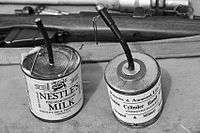Jam tin grenade
| Double-cylinder grenade | |
|---|---|
|
Reproduction of a trench improvised explosive device in a milk tin, and a similar manufactured double cylinder grenade | |
| Type | Hand grenade |
| Place of origin | Australia |
| Service history | |
| In service | 1915 - |
| Specifications | |
| Filling | Ammonal + steel fragments |
Detonation mechanism | Timed friction fuse |
The double cylinder, No 8 and No 9 hand grenades, also known as the "jam tin", is a type of improvised explosive device used by the Australian and New Zealand armies in World War I. The jam tin, or bully beef tin, was one of many grenades designed by ANZACS in the early part of the First World War in response to lack of equipment suited to trench warfare.
The grenade was an inner can of explosive with an outer can of metal fragments or ball bearings. The heavier pattern No 9 grenade contained more high explosive and more metal fragments.
The fuse was ignited by a friction device or a cigarette.
Initially when demand for grenades was at its greatest, engineers were encouraged to improvise their own grenades from the tins containing the soldier's ration of jam, hence the name. Incidents with the improvised form and the supply of superior grenades led to official withdrawal of the design.
Jam tin grenades were used as booby traps by ANZACS, by rigging it to a pressure trigger and leaving it under a body or other heavy object to keep it unarmed until it was disturbed.
References
- Wintirngham, Tom (2 March 1940). "Shells and Grenades". Picture Post.
